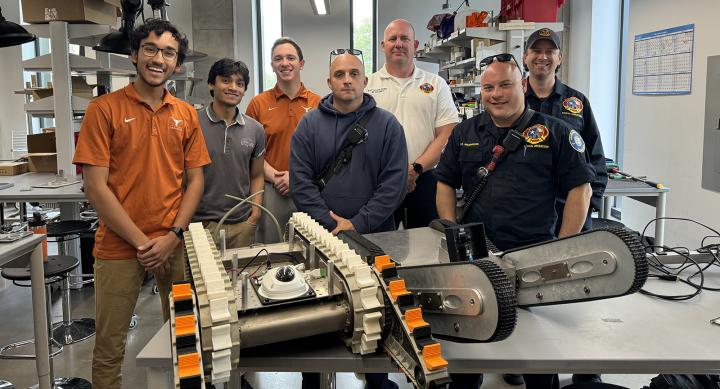
Siddharth Thakur (far left) and the rest of the team at Paradigm Robotics with FireBot.
Star Wars’ C-3PO is known for being shiny, risk-averse, and, of course, fictional. He might also be the opposite of the real-world future of robotics, which electrical engineering senior Siddharth Thakur is building with rugged machines that put themselves in danger.
Thakur and collaborators at Paradigm Robotics developed FireBot, a low-slung robot designed for emergency response. Its design is more functional than humanoid, and it moves on treads — it’s more akin to R2-D2 than C-3PO. By taking robots out of sci-fi scenarios and dropping them into dangerous real-world situations, Thakur hopes to save money and lives. Pilot versions of the FireBot have been designed to crawl into structure fires, hazardous material sites, and other spaces where reconnaissance and rescue can be unsafe or even deadly for humans. By having a robot take on the risk during recon, human responders can be better informed and safer as they carry out their work.
“My goal has always been to save a life with this,” he says. “There are over 500,000 structure fires a year. That's one every 60 seconds. And that's only getting worse with an 8% year-over-year increase, from climate change, from building materials getting cheaper and vacant buildings. So, the impact is enormous.”
FireBot’s potential spans multiple industries, from commercial warehouses and industrial sites to police and fire departments. Thakur has been targeting these different audiences through partnerships, pitch competitions, and product demos.
“Each key industry that we target has the same thing — they have incidents, and they're not very safe for humans, but right now they're sending humans to them. So, our potential impact really is making the standard of care higher for emergency response to civil workers, and then just increasing the chance that they come home safely.”
In addition to saving lives in these settings, Thakur sees potential for the FireBot to save money — for example, by using it for recon that can reduce losses in warehouses, as well as injury-related expenses to fire departments. This, in turn creates, a business potential for the project, which means that his research experience has dovetailed with entrepreneurship.
“There aren’t many rugged robots,” Thakur notes. “We’ve been finding our niche in this field of rugged robotics and then really differentiating ourselves from others in this space by being very cheap and affordable.”
Thakur sees some similarities between running a startup and getting involved in research in the first place.
“Research has been my lifeblood for years,” he says. “For any interested person who wants to do research, have an open mind. E-mail professors, go up to talk to them, go to their office hours, say hello.
“If you want to convert that into startup, I think my biggest feedback for anyone is to do the same thing again — all of this is based on opportunities and just knocking on doors. The more you do that, the better.”
In addition to getting support from nearly every entrepreneurship center on campus, Thakur has found support for his project through the Office of Undergraduate Research. A video about his project won an award at the Texas Student Research Showdown, and he received a $1,000 Undergraduate Research Fellowship.
“It was literally the support of each university group that I work with. Even the $1,000 URF — each dollar went into building this robot.”
Through a research experience that has bolstered his technical skills as well as his ability to build and pitch a business, Thakur has taken advantage of the many opportunities available to undergraduate researchers and entrepreneurs at The University of Texas at Austin. His advice is for other students to do the same.
“Reach out,” he says. “Knock on every door you see.”

